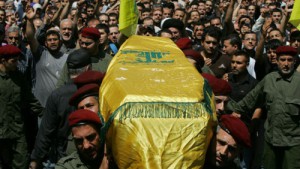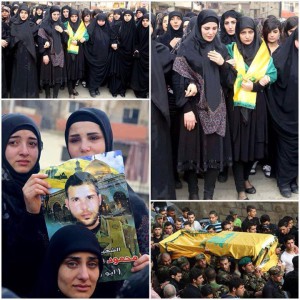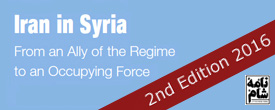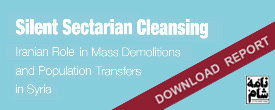 The latest news from Yabroud confirms that the town has fallen in the hands of Bashar al-Assad’s army and Hezbollah Lebanon forces, following a month of fierce resistance by opposition fighters. Naame Shaam’s correspondent near Yabroud has sent the following dispatches explaining how and why that happened.
The latest news from Yabroud confirms that the town has fallen in the hands of Bashar al-Assad’s army and Hezbollah Lebanon forces, following a month of fierce resistance by opposition fighters. Naame Shaam’s correspondent near Yabroud has sent the following dispatches explaining how and why that happened.
– Yabroud is surrounded by a series of rocky mountains (al-Qalamon), which made it difficult for the Syrian regime and Hezbollah ground troops to ‘conquer’ it. The armed opposition forces had secured the only few paths through the mountains and held their ground for over a month.
– But due to the strategic importance of Yabroud (it was one of the last remaining Syrian opposition strongholds near the Lebanese border, connecting the rebels in Qalamon to allies and supplies coming from the adjacent Lebanese town of Arsal, so taking Yabroud meant cutting this lifeline, as well as securing the Damascus-Homs-Aleppo highway), the Syrian regime forces and Hezbollah Lebanon put their full forces behind the military campaign. Media reports claimed Hezbollah Lebanon had sent at least 2,000 of some its best fighters to fight in Yabroud. [1]
– But even this did not seem enough. After about two weeks of ‘skirmishes’ and a growing toll of casualties among Hezbollah and the Syrian army, various Arabic media reported that fighters from the notorious Iraqi Shia militia known as the Badr Legion were sent to their rescue. [2] The Badr Legion was set up by Sepah Pasdaran during the Iranian-Iraqi war.
– After a week or so, as the Assad and Hezbollah forces failed to enter Yabroud, they started to besiege the town, cut off electricity and subject it to heavy, indiscriminate bombardment, in the hope that the opposition fighters would eventually get out of their shelters, or that the civilian residents would ask them to leave when they could no longer cope with the brutal air strikes targeting their homes. All sorts of weapons were used, from developed Russian and Iranian missiles (Scud and Burkan [3]) to cannons and barrel bombs. [4]
– Sometimes the shelling was so intense that one could barely catch one’s breath. [5] As one local activist from the Yabroud Coordination Committee put it, “the amount of missiles fired on Yabroud, and the number of troops amassed, would have been enough to destroy large parts of Israel or take over Washington DC.”
– Significantly, it was not just the Syrian air force firing rockets and barrels in order to pave the way for the ground troops, accompanied by Hezbollah and Iraqi militias; Hezbollah Lebanon was also firing its own missiles. [6]
– On the opposition side, the majority of the fighters in Yabroud belonged to local, relatively ill-equipped brigades, who were fighting under the umbrella of the so-called United Military Command in Qalmon. They were later joined by fighters from al-Qaeda-linked Jabhat al-Nusra, and later by some from the Ahrar al-Sham, [8] which is now part of the Islamic Front.
– On Saturday and Sunday, 15 and 16 March 2014, clashes between the two sides intensified on the eastern fronts (near Rima and al-Aqabeh). Eventually, Syrian regime forces, along with Hezbollah and Badr fighters, managed to enter Yabroud. Tens of fighters on both sides were reportedly killed in the process.
– Most of the opposition fighters who stayed alive withdrew to the neighbouring towns and villages, mainly to Rankous. Some crossed the border into the Lebanese town of Arsal. Those who remained in Yabroud were involved in desperate street battles with the invading forces throughout Sunday, especially in the Qa’a and Qami’yya neighbourhoods. Eyewitnesses says the town is now “deserted and completely destroyed.”
– Hezbollah had apparently built sand barriers on the other side of the border, but I have not been able to verify this. The Syrian air force also carried out an air strike on Arsal on Sunday, but no casualties were reported.
– Most of the civilian residents of Yabroud (estimated to be have been around 100,000), as well as some 150,000 internally displaced Syrians who had come from elsewhere to seek refuge there, had fled the town throughout the previous month, with the help with the Free Syrian Army. [8] A few hundred had apparently remained in Yabroud, either because they were too old to travel or because they refused to leave their homes. They were reportedly safely evacuated by the Free Army in the last few days before the regime and Hezbollah forces entered Yabroud. Some of the early waves of exodus had been fired on by Syrian fighter jets. [9]
– Tens, if not hundreds, of Hezbollah Lebanon fighters have been killed in Yabroud since the military campaign started in mid-February. [10] Last week alone, Hezbollah held an official funeral for 56 of them after the bodies were returned to Lebanon. [11] Many corps have not been retrieved, according to Syrian opposition fighters.
COMMENT FROM THE EDITOR:
While the fall of Yabroud has been portrayed by Hezbollah, Syrian and Iranian state-controlled media as a ‘victory’, the reality is that the huge, month-long military campaign has cost Hezbollah and Iran a great deal of money, weapons and souls – not to mention the obvious question of whether flattening a whole historical town and displacing its entire population can ever be regarded as a victory.
Like the battle of Qusayr, near Homs, in summer 2013, Hezbollah and Sepah Pasdaran seem to have massively underestimated how long and how much it would take to ‘conquer’ Yabroud. Even if figures cited by the Syrian opposition were inaccurate or exaggerated, a quick estimation of the costs of the whole campaign to the Iranian public purse would easily put the figure in the tens of millions of dollars in the most conservative estimates. And that’s only taking account the declared or documented losses (deaths and destroyed weapons and machinery). Then there are all the running costs (food, transport, fuel, salaries, etc.) for the declared or documented numbers of fighters, as well as the monthly salaries that all Hezbollah martyrs’ families will be receiving from the group as a bribe. All of these are paid for by the Iranian government.
Meanwhile, Naame Shaam’s correspondent in Beirut, Lebanon, says a growing number of people living in Hezbollah strongholds in Lebanon are growing increasingly “tired of the war” as the human and economic costs to them continue to climb, not to mention the legitimate fear that their areas are fast becoming part of the Syria war, not least as targets for suicide bombs. This was only to be expected as more and more of their sons die in a war that is not really theirs, more and more people leaving to live somewhere else safer, business being slow due to the heightened security measures and so on. Similar feelings of frustration and resentment also are starting to boil among Iranians, albeit still largely under the surface.
As we, at Naame Shaam, keep saying, it is time for everyone to realise that Syria is turning into Iran’s Vietnam. It has already turned into one, in fact, and it’s only a matter of time before Iranians and their government start to really feel the heat.
NOTES:
[1] http://www.orient-news.net/index.php?page=news_show&id=7839
[2] http://www.aawsat.com/details.asp?section=4&article=763334&issueno=12879
[3] http://warwentviral.com/2014/02/12/new-photograph-of-two-volcano-dual-launchers-in-yabroud-posted-on-pro-hezbollah-page/
[4] See, for example, these videos: https://www.youtube.com/watch?v=uwN9EG4ppMQ and https://www.youtube.com/watch?v=LfVuwsRHljg
[5] See, for example, this video: https://www.youtube.com/watch?v=1ep4-KruYLs
[6] See these two videos, in which you can clearly hear a distinct Lebanese accent:
http://www.liveleak.com/view?i=bf0_1393772640 and http://www.youtube.com/watch?v=LO-6S5KKP8o
[7] See https://www.youtube.com/watch?v=X3TLh7LrMNk
[8] See, for example, this report http://www.reuters.com/article/2014/02/15/us-syria-crisis-idUSBREA1D11920140215
[9] http://www.telegraph.co.uk/news/worldnews/middleeast/syria/10639926/Syrian-fighter-jets-fired-on-civilians-fleeing-rebel-town.html
[10] See, for example, these reports:
http://arabic.cnn.com/middleeast/2014/03/15/syria-ghozlan
http://www.all4syria.info/Archive/132097
http://www.orient-news.net/?page=news_show&id=8137
http://www.orient-news.net/index.php?page=news_show&id=7818
http://www.orient-news.net/index.php?page=news_show&id=7824
http://www.orient-news.net/index.php?page=news_show&id=7831
http://www.orient-news.net/index.php?page=news_show&id=8154
[11] Al-Arabiyya, http://tinyurl.com/kyxerbj
[12] See, for example,
http://english.farsnews.com/newstext.aspx?nn=13921225000627
http://www.almanar.com.lb/english/adetails.php?eid=140908&cid=23&fromval=1&frid=23&seccatid=20&s1=1
 English
English  فارسی
فارسی  العربية
العربية 




 On Twitter
On Twitter